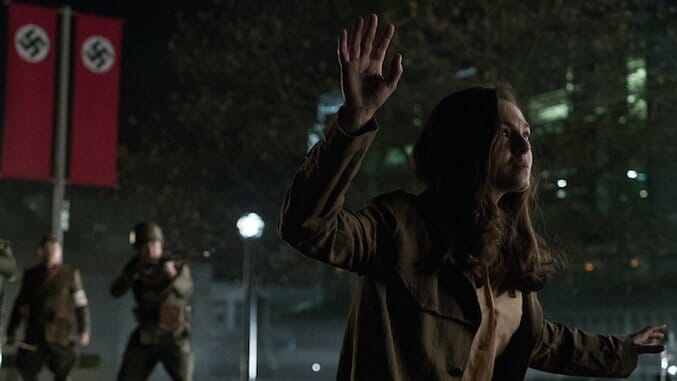Why Amazon’s The Man in the High Castle Is the Sci-Fi Show for the “Post-Truth” Era
Amazon Prime Video/Liane Hentscher
“It’s a strange perfect storm of events, as of late, that have made this show more timely and relevant in certain ways than we ever would have expected,” says Isa Dick Hackett, executive producer of The Man in the High Castle.
The Amazon original series, based on the 1962 novel by Philip K. Dick, could have landed on a number of other networks—or perhaps even in cinemas—at any other time. But the dystopian drama, set in an alternate history where the United States loses World War II, seems destined for now. Hackett, who is Dick’s daughter, had been working on an adaptation of The Man in the High Castle for years. “It’s really a crown jewel of the library,” she adds. But, literary achievement aside, it wasn’t working as a film. Networks showed interest in it as a series, but those opportunities ultimately didn’t pan out either. Now, nearly a decade after she started working with executive producer David Zucker on the project, the series is about to begin its second season on Amazon. And it couldn’t be more timely.
The Man in the HIgh Castle debuted last year to critical acclaim. For the uninitiated, the show depicts a not-so-United States in the years following World War II. Germany has taken over the Eastern states. Japan has the West Coast. In between is the neutral zone set along the Rocky Mountains. When Juliana Crain (Alexa Davalos), a woman in San Francisco, comes into possession of a newsreel-style film that depicts victory for the Allies, it sets her on a journey that will impact everyone around her. While the show finished its first season in a place meant to leave viewers wanting more, a lot has changed between then and now.
“It’s an extremely challenging show, particularly because we had an unusual process and production this year,” says Hackett. “People were put in situations and given tasks that were very difficult and not only rose to the occasion, but exceeded expectations, for the actors and the production.”
Showrunner Frank Spotnitz stepped down last May. “We shut down for a little bit and then we made some creative adjustments for the back half of the season,” says Hackett. “We didn’t have the luxury of time, so the writers were rock stars and they wrote these scripts. The production, the set directors and designers and wardrobe, they all just rose to the occasion in a very short amount of time and still gave us an incredibly gorgeous show.”
But the strangest thing about The Man in the High Castle isn’t what happened behind the scenes. It’s what happened in the U.S. less than six weeks before the second season’s premiere. Donald Trump won the presidential election. A stunned nation is now wrestling with “fake news” and “post-truth.” Now, on December 16, we’ll be heading back into a fictional world where the core question is: What is real?
“Though he was prescient, even in terms of ideas of technology, it was never about the technology. It was about how the technology impacted people, how it impacted the human condition,” Hackett says of her father’s work. “The core themes are what it means to be humans and what is real, what is reality. Those are two core questions that he explored throughout all of his work and you find these themes running through consistently.”
All this makes The Man in the High Castle a crucial show for this moment in U.S. history.
The source material stems from a time when John F. Kennedy was still president. The Civil Rights Movement, and the push to end segregation in the South, was ongoing. Plus, World War II was still relatively recent history for the citizens of the U.S. Cary-Hiroyuki Tagawa, who plays Nobusuke Tagomi, Trade Minister for the Pacific States, notes how rebellious a move that was. “World War II is really the backbone of what our modern, American concept is of ourself,” says Tagawa. “We won the war. We are the ones you need to listen to. We got the atomic bomb, so you better listen to us or we’ll drop the bomb.”
He adds, “That sort of split, and the difference between that kind of power and muscle politics and true power—the true, internal, human soul power—that’s part of what’s in this whole series.”
As Stephen Root, who makes his debut this season as Hawthorne Abendsen, the actual Man in the High Castle, says of a Season Two sequence in which students pledge allegiance to the Nazi flag, “With very small differences, that was exactly the experience I had, going to school, saying the Pledge of Allegiance, and it was kind of frighteningly similar to how easily that set of circumstances could have happened.”
-

-

-

-

-

-

-

-

-

-

-

-

-

-

-

-

-

-

-

-

-

-

-

-

-

-

-

-

-

-

-

-

-

-

-

-

-

-

-

-








































